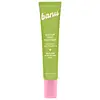What's inside
What's inside
 Key Ingredients
Key Ingredients

 Benefits
Benefits

 Concerns
Concerns

 Ingredients Side-by-side
Ingredients Side-by-side

Water
Skin ConditioningKaolin
AbrasiveBentonite
AbsorbentPropanediol
SolventSalix Alba Bark Extract
AstringentSulfur
AntiseborrhoeicMagnesium Aluminum Silicate
Absorbent1,2-Hexanediol
Skin ConditioningAscorbyl Glucoside
AntioxidantSilica
AbrasiveThymus Vulgaris Flower/Leaf Oil
MaskingOriganum Vulgare Leaf Oil
MaskingMelaleuca Alternifolia Leaf Oil
AntioxidantPotassium Azeloyl Diglycinate
Skin ConditioningMagnesium Sulfate
Zinc Sulfate
AntimicrobialAloe Barbadensis Leaf Juice
Skin ConditioningCinnamomum Camphora Bark Oil
MaskingCitrullus Lanatus Fruit Extract
Skin ConditioningGenipa Americana Extract
Skin ConditioningArginine
MaskingAcacia Senegal Gum
MaskingCitric Acid
BufferingCellulose Gum
Emulsion StabilisingAlgin
MaskingXanthan Gum
EmulsifyingMaltodextrin
AbsorbentSodium Citrate
BufferingSodium Phytate
Polyacrylate Crosspolymer-6
Emulsion StabilisingAluminum Hydroxide
EmollientHydroxyacetophenone
AntioxidantCI 77891
Cosmetic ColorantWater, Kaolin, Bentonite, Propanediol, Salix Alba Bark Extract, Sulfur, Magnesium Aluminum Silicate, 1,2-Hexanediol, Ascorbyl Glucoside, Silica, Thymus Vulgaris Flower/Leaf Oil, Origanum Vulgare Leaf Oil, Melaleuca Alternifolia Leaf Oil, Potassium Azeloyl Diglycinate, Magnesium Sulfate, Zinc Sulfate, Aloe Barbadensis Leaf Juice, Cinnamomum Camphora Bark Oil, Citrullus Lanatus Fruit Extract, Genipa Americana Extract, Arginine, Acacia Senegal Gum, Citric Acid, Cellulose Gum, Algin, Xanthan Gum, Maltodextrin, Sodium Citrate, Sodium Phytate, Polyacrylate Crosspolymer-6, Aluminum Hydroxide, Hydroxyacetophenone, CI 77891
Sulfur 10%
AntiseborrhoeicWater
Skin ConditioningGlycerin
HumectantKaolin
AbrasiveBentonite
AbsorbentPropylene Glycol
HumectantNiacinamide
SmoothingSorbitol
HumectantCI 77891
Cosmetic ColorantPhenoxyethanol
PreservativeHamamelis Virginiana Water
AstringentAcacia Senegal Gum
MaskingXanthan Gum
EmulsifyingAlpha-Glucan Oligosaccharide
CleansingCarbomer
Emulsion StabilisingPolyglyceryl-4 Caprate
EmulsifyingPolyglyceryl-6 Caprylate
EmulsifyingCI 77288
Cosmetic ColorantButylene Glycol
HumectantPotassium Sorbate
PreservativeSodium Benzoate
MaskingGlycyrrhiza Glabra Root Extract
BleachingSalix Nigra Bark Extract
Skin ProtectingCamellia Sinensis Leaf Extract
AntimicrobialBenzoic Acid
MaskingSulfur 10%, Water, Glycerin, Kaolin, Bentonite, Propylene Glycol, Niacinamide, Sorbitol, CI 77891, Phenoxyethanol, Hamamelis Virginiana Water, Acacia Senegal Gum, Xanthan Gum, Alpha-Glucan Oligosaccharide, Carbomer, Polyglyceryl-4 Caprate, Polyglyceryl-6 Caprylate, CI 77288, Butylene Glycol, Potassium Sorbate, Sodium Benzoate, Glycyrrhiza Glabra Root Extract, Salix Nigra Bark Extract, Camellia Sinensis Leaf Extract, Benzoic Acid
 Reviews
Reviews

Ingredients Explained
These ingredients are found in both products.
Ingredients higher up in an ingredient list are typically present in a larger amount.
Acacia Senegal Gum has skin soothing, thickening, and formulation stabilizing properties. It comes from the Acacia tree that is native to sub-Saharan Africa.
Bentonite is an aluminium phyllosilicate clay with great absorbent properties. The name 'bentonite' comes from the area where the largest source is found: Fort Benton, Wyoming.
As a clay, bentonite is often used to absorb excess oil and provide exfoliation. It has also been shown to have some antibacterial and anti-inflammatory properties. Studies show bentonite was effective at calming dermatitis from poison ivy and in diaper dermatitis of infants. Bentonite has also been shown to act as a barrier against toxic compounds on your skin.
Sunscreens containing bentonite display higher water resistance and stay on the skin for much longer. The sunscreens containing bentonite also show higher potency and UV light absorbtion.
Bentonite is naturally created from volcanic ash and several natural weathering/hydrothermal processes.
A common usage of bentonite is removing excess protein from white wines. Bentonite contains a property of being able to absorb large amounts of protein from aqueous solutions.
Phyllosilicate clay has a structure formed by sheets.
Learn more about BentoniteCi 77891 is a white pigment from Titanium dioxide. It is naturally found in minerals such as rutile and ilmenite.
It's main function is to add a white color to cosmetics. It can also be mixed with other colors to create different shades.
Ci 77891 is commonly found in sunscreens due to its ability to block UV rays.
Learn more about CI 77891Kaolin is a clay. It is used for oil control and to help minimize pores. Like other clays, kaolin has the ability to absorb excess sebum or oil. This can help clean out pores and mattify the skin.
Some types of kaolin may have exfoliating properties. When water is added to kaolin, it becomes a paste with small abrasive particles.
Most kaolin is a white color, but may be pink/orange/red depending on where it comes from.
The name 'kaolin' comes from a Chinese village named 'Gaoling'. Kaolin clay comes from rocks rich in kaolinite. Kaolinite, the mineral, has a silicate layered structure. Kaolinite is formed from chemical weathering of aluminum siilicate minerals.
Besides skincare, kaolin is commonly used to make glossy paper, in ceramics, toothpaste, and as medicine to soothe stomach issues.
Learn more about KaolinSulfur is a commonly occurring element on Earth (and our universe!). In cosmetics, it helps kill bacteria, reduces sebum, and provides exfoliation. This makes it an effective ingredient to reduce breakouts and fight acne.
As a ketayolytic agent, it breaks down the top layer of skin. This is a form of exfoliation and may help decrease acne and hyperpigmentation.
Studies show sulfur has antibacterial and antifungal properties. Sulfur can be drying if used excessively or at higher concentrations. We recommend speaking with a medical professional if you have any concerns.
Ancient Greece, India, China, and Egypt have used sulfur in both traditional medicines and for household use.
Learn more about SulfurWater. It's the most common cosmetic ingredient of all. You'll usually see it at the top of ingredient lists, meaning that it makes up the largest part of the product.
So why is it so popular? Water most often acts as a solvent - this means that it helps dissolve other ingredients into the formulation.
You'll also recognize water as that liquid we all need to stay alive. If you see this, drink a glass of water. Stay hydrated!
Learn more about WaterXanthan gum is used as a stabilizer and thickener within cosmetic products. It helps give products a sticky, thick feeling - preventing them from being too runny.
On the technical side of things, xanthan gum is a polysaccharide - a combination consisting of multiple sugar molecules bonded together.
Xanthan gum is a pretty common and great ingredient. It is a natural, non-toxic, non-irritating ingredient that is also commonly used in food products.
Learn more about Xanthan Gum